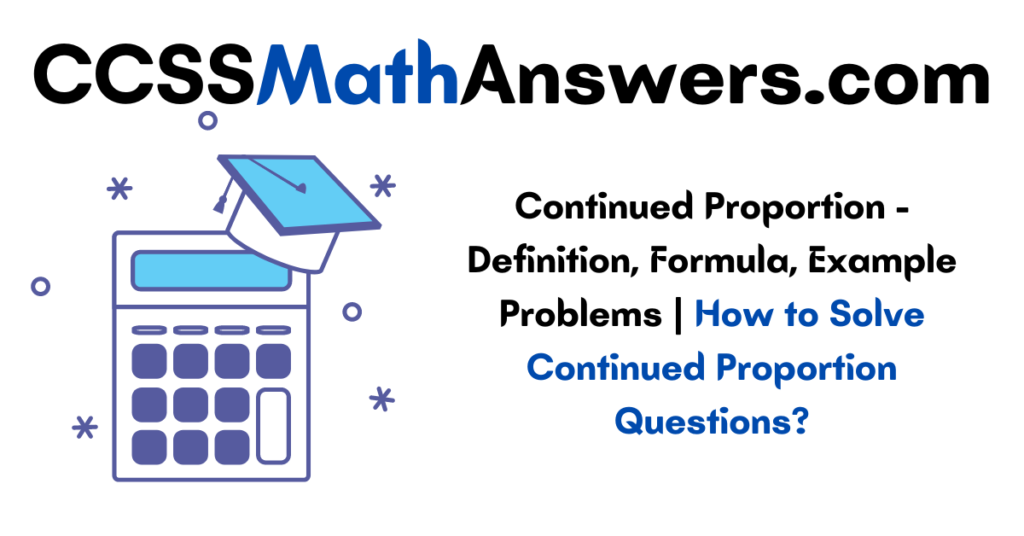A proportion is a statement where the specified two ratios are similar. These proportions are of three types such Direct, Indirect, and Continued Proportion. In this article, we will see the detailed Explanation of the Continued Proportion with the Respective Formula which is more advantageous to the 6th Grade Math students. The concept and Step by Step Approach used while explaining the Example Questions make it easier and simple to solve similar kinds of Problems on Continued Proportion.
Read more:
Continued Proportion – Definition | What do you Mean by Continued Proportion?
Continued Proportion is a kind of proportion wherein the ratio of first and second quantities is equal to the ratio between second and third quantities. Let us consider three numbers x, y, and z such that x : y = y : z when x , y, and z are in continued proportion. It is often called Mean Proportional. In this case, y is the mean proportional.
Continued Proportion Formula
To Know whether the given terms are in Continued Proportion a formula is used for evaluating the given numbers as shown below.
x : y = y : z
By applying the Cross Product Rule
Product of Extreme terms = Product of Mean terms
y. y = x.z
y2 = xz
Continued Proportion Problems with Solutions
Question 1.
What is the mean proportional value for 5 and 7?
Solution:
As per the given question, the second proportional is missing let the value be y which is unknown.
As we know the continued proportion formula x : y = y : z. By substituting both the given values we get 5: y = y: 7
By cross multiplying y2 = 5 x 7
y 2 = 35
y = 5.91 is the mean proportional value
Question 2:
Calculate the value of p when 10, 6, and p are in continued proportion?
Solution:
Given that 10, 6, and p are the three numbers where the p is an unknown value. Applying the cross product rule y2 = xz
we obtain it as 10.p = 6 2
10p = 36
p = 36 / 10
p = 3.6 is the resultant value for the given numbers.
Question 3:
Does the given three numbers 4, 8, and 9 in continued proportion?
Solution:
Given 4, 8, and 9 numbers. To verify the given numbers we need to implement the continued proportions formula x : y = y : z. By substituting the values 4 : 8 = 8 : 9.
Calculate the product of Extreme terms: 8 x 8 = 64
product of Mean terms: 4 x 9 = 36
product of Extreme terms is not equal to the product of mean terms. So the given numbers are not in continued proportion
FAQ’s on the Concept of Proportion
1). What is the continued proportion?
A type of proportion where x: y = y: z. i.e. Ratio of the first and second term and the ratio of the second term and third term.
2). What is the other name for continued proportion?
It is often called with the other name as a mean Proportional.
3). Give the Formula for the cross-product rule when doing the problems in case of proportions?
y2 = xz is the formula for calculating the cross-product Rule.
4). How can you know that the given numbers are in continued proportion?
By verifying with the cross product formula it is checked for a given number.
5). Are the numbers 2, 16, and 7 in continued proportion?
Implement the formula and calculate 2 : 16 = 16 : 7 i.e. 162 = 2 x 7
256 = 14 .So the Product of Extreme terms is not equal to the product of Mean terms. Hence the given numbers are not in continued proportion.
6). Are the numbers 4, 3, and 4 in proportion?
Implement the formula and calculate 4 : 3 = 3: 4. Then calculate the Product of Extreme terms and product of Mean terms as 3 x 3 = 4x 4
9 = 16. So the three numbers 4, 3, and 4 are not in proportion.
7). Is continued proportion a type of proportion?
Yes, the continued proportion is a third type of Proportion.
